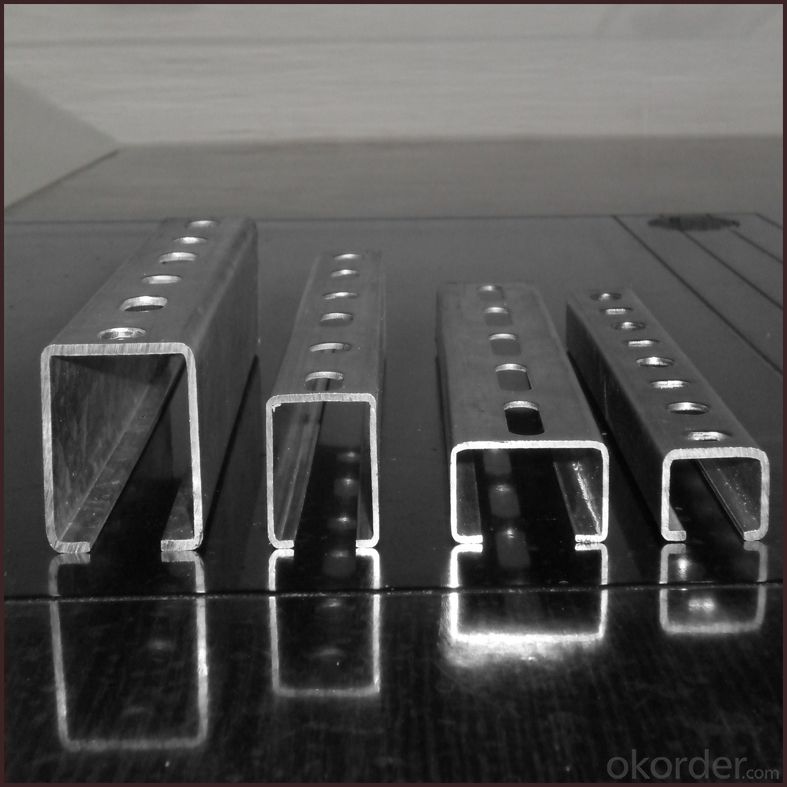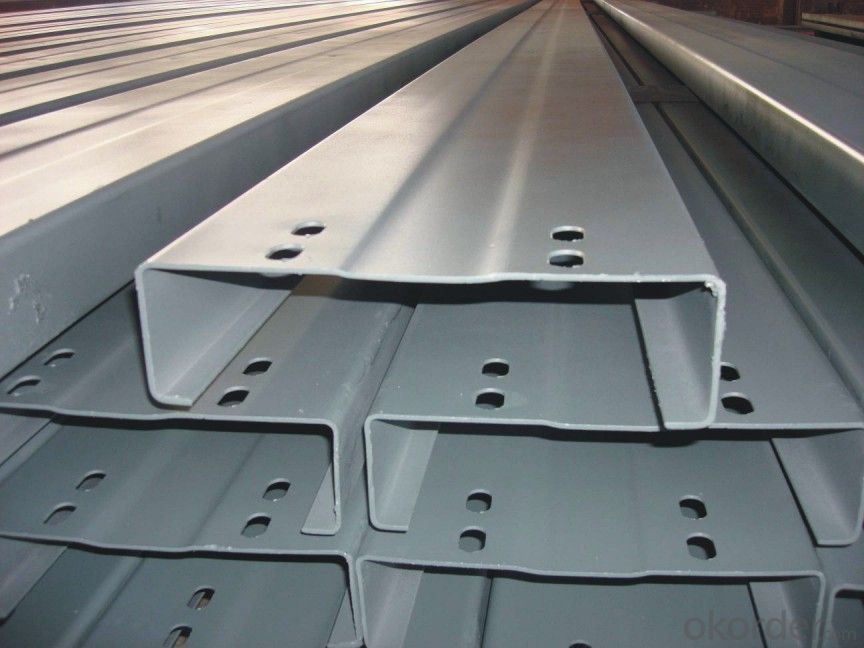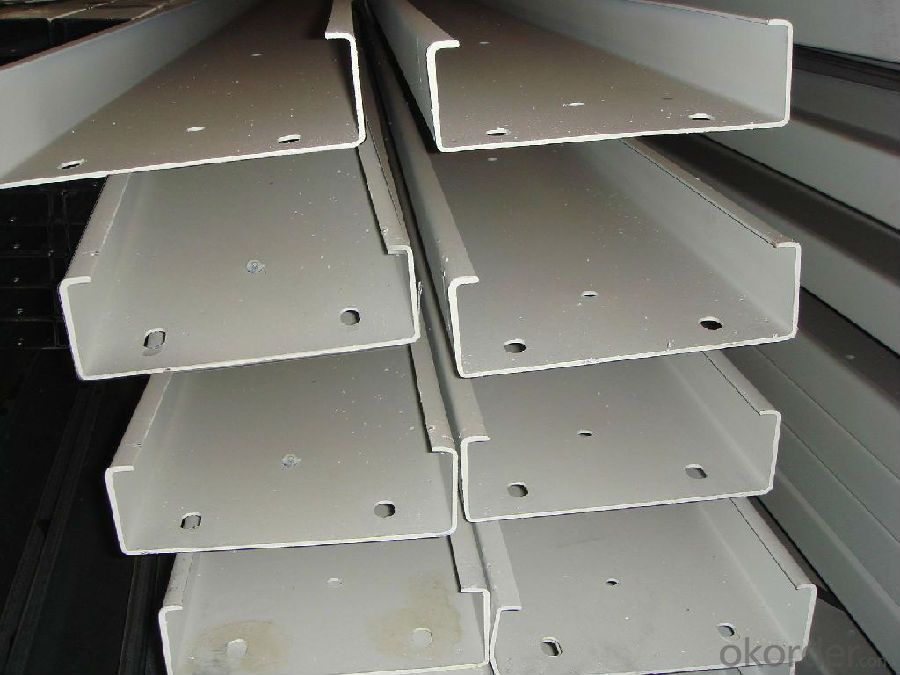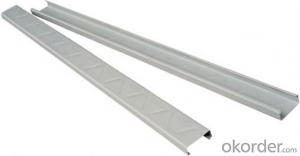C Channel Hot dipped Galvanzied Unistrut Channel
- Loading Port:
- Tianjin
- Payment Terms:
- TT or LC
- Min Order Qty:
- 28 m.t.
- Supply Capability:
- 30000 m.t./month
OKorder Service Pledge
OKorder Financial Service
You Might Also Like
1,Structure of C Channel Hot dipped Galvanzied Unistrut Channel
Our factory main produce steel profile of suspended ceiling system and drywall partition system, including drywall stud & track, ceiling main & cross tee, wall angle, C-channel, Omega, Accessories etc.
1> Our series products main supply to Eastern Europe like Russia, Ukraine etc.
CD60*27
UD28*27
CW50*50, 75*50, 100*50
UW50*40, 75*40, 100*40
2,Main Features of C Channel Hot dipped Galvanzied Unistrut Channel
2> Our series products main supply to Middle East.
C-Channel 38*12
Omega 68*35
Stud 41*35, 50*35, 63*35, 70*32, 70*34.5, 75*35, 100*35
Track 41*25, 50*25, 63*25, 72*25, 75*25, 100*25
Angle 25*25
3> Our series products main supply to Australia, New Zealand.
Top Cross Rail 25*21
Furring channel 28*38, 16*38
Furring channel track 28*20*30,16*20*30
Stud 51*33.5*35.5,64*33.5*35.5, 76*33.5*35.5, 92*33.5*35.5, 150*33.5*35.5
Track 51*32*32, 64*32*32, 76*32*32, 92*32*32, 150*32*32
Length and thickness can be customized as customers request
Material: high-quality hot dipped galvanized steel coil.
Advantage of C Channel Hot dipped Galvanzied Unistrut Channel
High quality & reasonable Price, no need welding and punching, can use repeatedly, wide usage range, flexible for installation.
1. Strut Channel Standard Size: 21*21, 41*21, 41*25, 41*23, 41*41,41*62,41*72,41*82
2. Strut Channel Standard thickness: 1.5mm, 2mm, 2.5mm,2.75mm, 3.0mm
3. Strut Channel length: 2440mm, 3000mm, 5800mm, 6000mm and customized
4. Strut Channel Standard Type: back to back, 41*41.41*62, 41*123 and so on
5. Strut Channel Standard Hole Size:14x29mm, 10x76mm,22mm,14mm.
6. Strut Channel Standard Model: Slotted / Perforated / Punched Hole, and Solid.
7. Strut Channel Standard Material: Q235B, Stainless Steel, Aluminum.
8. Strut Channel Standard Surface Finish: Black, Pre-galvanized, Hot Dipped Galvanized,Electro Galvanzied,
SS304, SS304L,SS316,SS316L, Aluminum, Painted Color / Powder Coated.
9. Strut Channel Availble Doucments: Catalogues, Drawings, Photos, Price List, Certificates, Test
Report, Factory Inspecition, After-sales Service and So on.
10. Strut Channel Standard Delivery Time: 7 working days for 1x20ft Container.
Other sizes be produced according to customer’s drawing.
Images of C Channel Hot dipped Galvanzied Unistrut Channel



- Q:How do steel channels compare to other structural shapes?
- Steel channels are a structural shape that is versatile and widely used, offering various advantages compared to other shapes. One of the main benefits of steel channels is their high ratio of strength to weight. Their shape provides excellent support and load-bearing capacity, enabling the construction of strong and durable structures. In contrast to I-beams or angles, steel channels have a unique cross-section in the shape of a C, which provides greater resistance to bending. This makes them particularly suitable for applications where bending or torsional forces are present, ensuring the stability and integrity of the structure. Furthermore, steel channels come in a wide range of sizes and configurations, making them highly adaptable to different construction needs. They can be easily customized and cut to specific lengths, allowing for precise installation and minimizing waste. This versatility makes steel channels a popular choice in industries such as construction, manufacturing, and engineering. Another advantage of steel channels is their cost-effectiveness. Steel is a comparatively affordable material, and using steel channels efficiently in construction projects can optimize costs without compromising structural integrity. Additionally, steel channels have excellent corrosion resistance, extending their lifespan and reducing maintenance and replacement expenses. To summarize, steel channels offer numerous advantages over other structural shapes. Their high strength-to-weight ratio, resistance to bending, adaptability, and cost-effectiveness make them a reliable choice for various construction applications.
- Q:Can steel channels be customized to specific dimensions?
- Yes, steel channels can be customized to specific dimensions. Steel channels are versatile and can be fabricated to meet specific requirements in terms of width, height, and thickness. This customization is achieved through various manufacturing processes like cutting, bending, and welding. By altering these dimensions, steel channels can be tailored to fit specific applications and structural requirements. Whether it is for construction, machinery, or any other industry, steel channels can be customized to meet the desired dimensions and specifications.
- Q:Can steel channels be used for HVAC ductwork?
- Yes, steel channels can be used for HVAC ductwork. Steel channels are commonly used in construction for their strength and durability. When properly installed and sealed, steel channels can effectively distribute air throughout a building for heating, ventilation, and air conditioning purposes. They can be customized to fit specific ductwork designs and are suitable for both residential and commercial applications. Steel channels also provide a fire-resistant option for HVAC ductwork, making them a popular choice in many buildings.
- Q:How do steel channels contribute to the overall stability of a structure?
- Steel channels contribute to the overall stability of a structure in several ways. Firstly, steel channels provide structural support and reinforcement, distributing the load throughout the structure and preventing excessive deflection or deformation. The unique shape of a steel channel, with its flanges and web, offers increased strength and rigidity compared to other structural components. This allows the channels to resist bending, twisting, and buckling forces, ensuring the stability of the structure under various types of loads. Moreover, steel channels are often used as beams or columns, providing vertical support and enhancing the overall stability of a structure. When used as beams, steel channels can span long distances and carry heavy loads, minimizing the need for additional support structures. As columns, steel channels help transfer the vertical loads from the upper levels of the structure to the foundation, maintaining stability and preventing collapse. Additionally, steel channels can be interconnected to form trusses, which are highly efficient in distributing loads and resisting lateral forces such as wind or seismic activity. These trusses effectively transfer the loads to the foundation, ensuring the stability of the entire structure. Furthermore, steel channels can be used in combination with other structural elements, such as steel plates or concrete, to create composite sections that enhance stability and overall structural integrity. In summary, steel channels are crucial components in the construction industry, as they contribute significantly to the overall stability of a structure. Their ability to support heavy loads, resist deformation, and distribute forces efficiently makes them indispensable in ensuring the structural integrity and safety of buildings, bridges, and various other types of infrastructure.
- Q:What are the different types of steel channel accessories?
- There are several different types of steel channel accessories that are commonly used in various industries and construction projects. Some of the most common types include: 1. Brackets: Steel channel brackets are used to provide additional support and stability to the structure. They are typically used in combination with steel channels to secure them in place and prevent any movement or sagging. 2. Connectors: Steel channel connectors are used to join two or more steel channels together. They come in various designs, such as corner connectors or straight connectors, and are used to create a strong and secure connection between the channels. 3. End caps: Steel channel end caps are used to cover the exposed ends of steel channels. They provide a finished look to the structure and also help protect the channel from any damage or corrosion. 4. Mounting hardware: Steel channel mounting hardware includes various types of bolts, screws, and brackets that are used to attach the steel channels to walls, floors, or other surfaces. These accessories ensure a secure and stable installation. 5. Clips and clamps: Steel channel clips and clamps are used to secure cables, pipes, or other equipment to the steel channels. They provide a reliable and organized way to manage and secure various components within a structure. 6. Hangers: Steel channel hangers are used to suspend or hang different equipment, pipes, or cables from the steel channels. They are commonly used in HVAC systems, electrical installations, and plumbing applications to provide support and prevent sagging. 7. Slotted channels: Slotted steel channels are designed with slots or holes along the length of the channel. These slots allow for easy and adjustable mounting of various accessories, such as brackets, clamps, or hangers, without the need for additional drilling or modifications. Overall, these steel channel accessories play a crucial role in enhancing the functionality, stability, and appearance of steel channel structures in a wide range of applications.
- Q:Can steel channels be used for conveyor supports?
- Yes, steel channels can be used for conveyor supports. Steel channels are commonly used in industrial applications due to their strength and durability. They provide excellent support and stability for conveyors, which carry heavy loads and require a strong support structure. Steel channels can be easily fabricated, allowing for customization to fit specific conveyor requirements. They also offer resistance to corrosion and can withstand harsh operating environments. Overall, steel channels are a popular choice for conveyor supports due to their reliability and robustness.
- Q:Are steel channels suitable for use in the construction of conveyor systems?
- Yes, steel channels are suitable for use in the construction of conveyor systems. They are durable, strong, and provide excellent support for conveying materials. Steel channels can handle heavy loads, offer stability, and are resistant to wear and tear, making them an ideal choice for conveyor systems in various industrial applications.
- Q:What is the square bevel washer used for channel steel?
- The inclination of the channel steel and the angle of the square bevel washer coincide with the standard.
- Q:What's the weight of the 4 meter long 18 channel steel?
- 4 meter long channel 18 can withstand the weight of 2000 kilograms.
- Q:What are the different types of connections for steel channels in modular office systems?
- Steel channels in modular office systems can be connected using various methods to ensure stability and structural integrity. One widely used method is the bolted connection, which involves securing the steel channels together using bolts. These bolts are inserted through pre-drilled holes in the channels and then tightened with nuts. Bolted connections are relatively simple to install and offer a strong and dependable connection. Another option is the welded connection, which involves melting the metal at the connection points and allowing it to solidify, thereby joining the steel channels together. Welded connections are highly durable and provide exceptional strength. However, they require skilled labor and specialized equipment to be properly executed. A third alternative is the riveted connection, where rivets are used to secure the steel channels together. The rivets are inserted through pre-drilled holes in the channels and then deformed to hold them in place. Riveted connections are known for their ability to carry heavy loads and resist vibrations. However, they may be more time-consuming to install compared to bolted connections. Additionally, adhesive connections can also be used. This method involves using high-strength adhesives to bond the steel channels together. Adhesive connections are often used in combination with other connection methods to provide additional stability. They are particularly useful when drilling or welding is not feasible or desirable. To summarize, the available connection options for steel channels in modular office systems include bolted connections, welded connections, riveted connections, and adhesive connections. Each method has its own advantages and considerations, and the choice will depend on factors such as load requirements, installation limitations, and budget constraints.
1. Manufacturer Overview |
|
|---|---|
| Location | |
| Year Established | |
| Annual Output Value | |
| Main Markets | |
| Company Certifications | |
2. Manufacturer Certificates |
|
|---|---|
| a) Certification Name | |
| Range | |
| Reference | |
| Validity Period | |
3. Manufacturer Capability |
|
|---|---|
| a)Trade Capacity | |
| Nearest Port | |
| Export Percentage | |
| No.of Employees in Trade Department | |
| Language Spoken: | |
| b)Factory Information | |
| Factory Size: | |
| No. of Production Lines | |
| Contract Manufacturing | |
| Product Price Range | |
Send your message to us
C Channel Hot dipped Galvanzied Unistrut Channel
- Loading Port:
- Tianjin
- Payment Terms:
- TT or LC
- Min Order Qty:
- 28 m.t.
- Supply Capability:
- 30000 m.t./month
OKorder Service Pledge
OKorder Financial Service
Similar products
New products
Hot products
Related keywords





























